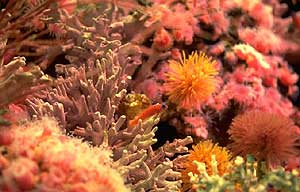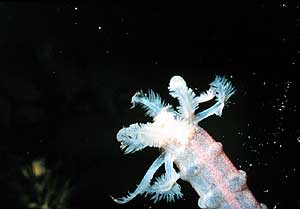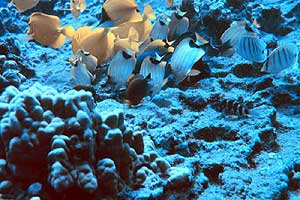
 Photo: Various types of coral provide a habitat for many tropical fish species. Image © 2003 www.clipart.com. |
 Photo: The sea cucumber, Euapta godeffroyi, is very common in Kaneohe Bay in Hawaii. It uses the rocks and holes of coral reef for a home. Photo courtesy of NOAA/Department of Commerce and Dr. James P. MCVey. |
 Photo: Colorful reef fish inhabit the rocky coral reefs on ocean bottoms. Photo courtesy of NOAA/Department of Commerce and Dr. James P. MCVey. |
Biosphere
Coral reefs have existed on Earth for many millions of years, but they weren't the first to build reefs. In early Earth history certain sponges and clams built reefs.
Today we know of more than 700 species of hermatypic (reef-building) coral. Brain, star, starlet, and elkhorn coral are some examples. These coral reefs serve as nurseries for growing aquatic life. They include the back-reef areas (seagrass beds and mangrove forests) and the many species that inhabit the reefs themselves. The most common inhabitants are the zooxanthellae algae, the most prevalent type of algae. They allow hard corals to build their stony homes by assisting them in the production of calcium carbonate. Many other species of algae also inhabit coral reefs.
Many colorful fish are part of the reef community. The holes and rocks in reefs provide habitat for such animals as sea cucumbers, sea urchins, sea snails, lobsters, crab, and shrimp. The world's coral reefs provide habitat to more than one million plant and animal species. Compared to the adjacent sea bed, coral reefs have a much higher biodiversity, one that only rainforests rival.
Coral reefs exist from the sea surface to as deep as 100 meters below. Growth is highest near the surface. There the zooxanthellae algae are better able to use the sun's energy in the process of photosynthesis. At night when photosynthesis cannot take place, the coral make less limestone. Nearly half of the carbohydrates that result from photosynthesis are used by the coral polyps. Zooxanthellae use the remainder for growth and reproduction. Coral polyps also feed upon microscopic zooplankton and phytoplankton.
Sometimes, however, the delicate balance between these species is upset by either natural or human-caused events. Coral spawn each autumn in Australia, for example. During low tides the liquid mixture of egg and sperm can cover large exposed areas. The decay of the spawning mix removes oxygen and results in the death of almost all creatures in the area, including coral themselves and fish.
In addition to natural events, humans often influence events in the biosphere. When fertilizer on the mainland runs off, it increases nutrients in the sea. Plants that thrive on nitrogen in the form of nitrates (contain the NO3- ion) from the fertilizer then grow to the point that they can choke out other plants. This eutrophication (increased nutrients) can lead to a decrease in biological diversity. For example, benthic algae are adjusted to high levels of nitrogen and grow at the expense of other organisms. This can lead to algal blooms that essentially can smother parts of a coral reef, blocking the sunlight required by the zooxanthellae for photosynthesis. This has been a problem in the Caribbean and the Florida Keys. In addition to agricultural nutrient runoff there, municipal wastes, septic tank seepage, and other sewage are added and provide more nutrients. Overfishing worsens the problem. Fish that would normally eat the algae are captured and killed.
The coral reefs off Australia and Thailand demonstrate the complexity of this problem. Apparently, excess nutrients there resulted in the growth of plants favored by the crown-of-thorns starfish. That species proliferated. This starfish also eats coral in very high amounts. Obviously a large number of them can destroy a reef in a relatively short time span. The anthrosphere describes other ways humans affect coral.
Anthrosphere | Atmosphere | Biosphere | Hydrosphere | Lithosphere
Glossary ..|.. Related Links ..|.. References |..PBL Model
Home ..|.. Teacher Pages ..|.. Modules & Activities
Maintained by ETE Team
Last updated
March 08, 2004
Privacy Statement and Copyright © 1997-2004 by Wheeling Jesuit University/NASA-supported Classroom of the Future. All rights reserved.
Exploring the Environment®, Coral Reefs was developed under a cooperative agreement with NASA.
Some images © 2004 www.clipart.com
Center for Educational Technologies, Circuit Board/Apple graphic logo, and COTF Classroom of the Future logo are registered trademarks of Wheeling Jesuit University.